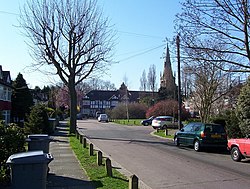Kingsbury, Middlesex
| Kingsbury | |
| Middlesex | |
|---|---|
 St Andrews Road and Church, Kingsbury | |
| Location | |
| Grid reference: | TQ195885 |
| Location: | 51°34’57"N, 0°16’27"W |
| Data | |
| Population: | 29,217 |
| Post town: | London |
| Postcode: | NW9 |
| Dialling code: | 020 |
| Local Government | |
| Council: | Brent |
| Parliamentary constituency: |
Brent North |
Kingsbury is an urban district of north-western Middlesex. The name Kingsbury means "The King's Manor". Its ancient scope stretches north and west to include Queensbury and parts of Kenton and Wembley Park in other directions. About a quarter of Kingsbury is Fryent Country Park, forming the southern quarter. It is of highly mixed density, ranging from high rise to suburban to a green wildlife reserve in the country park.
History
Kingsbury was historically a rural parish of a fairly modest 1,700 acres in the Gore Hundred of Middlesex.[1] It formerly included Queensbury.[2]
The early English kings had parted with their manor of Kingsbury long before the Norman Conquest. An estate called Tunworth, in the northern part of Kingsbury parish, was granted by Edwy to his thegn Lyfing in 957. By 1066 it probably formed part of the manor of Kingsbury, which was then held by Wlward White, a thegn of King Edward the Confessor, and passed from him to Ernulf of Hesdin who died in 1097 and his lands passed to the family of Walter of Salisbury. Thereafter the overlordship of Kingsbury descended with Edgware manor. By 1086 on the Domesday survey of property, Ernulf's manor in Kingsbury had been subinfeudated to Albold as Lord. It was not mentioned again until 1317, when, under the name of the manor of Kingsbury, it belonged to Baldwin Poleyn of Tebworth.[3]
Kingsbury developed little in housing and population in the 19th century, remaining a polyfocal village. In this age, Oliver Goldsmith, writer and playwright, lived at Hyde Farm, Kingsbury (1771–1774); the third Lord Mansfield was buried at St. Andrew's churchyard in 1840.
Although it lay close to London, development started slowly, and it was not until after the First World War that the district became built up. An aircraft industry was established in the part of Kingsbury adjacent to Hendon aerodrome during the war, while the road network was improved to cater for the British Empire Exhibition in nearby Wembley in 1924.[4] The number of inhabited houses in the civil parish increased from just 140 in 1901 to 3,937 in 1931. By 1951 this had risen to 11,776.[5] Between 1921 and 1931 Kingsbury's population increased by 796%.
Population growth meant the existing parish church, built in 1884, dedicated to the Holy Innocents, and adjacent to the more historic Old St Andrew's church, became too small. It was replaced during the 1930s. The current church, completed to designs by Samuel Daukes in 1847, had originally been constructed in Wells Street in central London but after its use declined it was deconstructed, transported and rebuilt (by Holland, Hannen & Cubitts, directed by architect William Adam Forsyth) in its entirety in Kingsbury in 1933–34.[6][7][8]
John Logie Baird's experimental television transmissions from the United Kingdom to Berlin, Germany were transmitted from the stable block of Kingsbury Manor, now the Veterans Club in Roe Green Park.
From 1923 to 1979 Kingsbury Road was the location of the Vanden Plas specialist motor body works, body makers for Bentley and later part of Austin, BMC, and British Leyland. The site is now Kingsbury Trading Estate.

A congregation of Jews affiliated to the United Synagogue is first recorded in Kingsbury in 1939. In 1942 Eden Lodge at Kingsbury Green was registered for worship, becoming Kingsbury district synagogue in 1954.[9]
In film, literature and music
The first two series of BBC children's drama Grange Hill were filmed at Kingsbury High School.[10] Video of Round Here, about George Michael's childhood, features Roe Green Park, Roe Green Primary School and other local landmarks.
Outside links
| ("Wikimedia Commons" has material about Kingsbury, Middlesex) |
- Kingsbury Heritage
- Kingsbury history
- Highfort Court, Buck Lane. Designed in the style of a fortified castle by local architect E. G. Trobridge
References
- ↑ A History of the County of Middlesex - Volume 5 : Kingsbury: Introduction (Victoria County History)
- ↑ A History of the County of Middlesex - Volume 5 p : Gore Hundred: Continued (Victoria County History): Map of established parishes
- ↑ A History of the County of Middlesex - Volume 5 : Kingsbury: Manors (Victoria County History)
- ↑ "Places in Brent: Kingsbury", Grange Museum of Community History and Brent Archive, accessed 28 January 2008.
- ↑ A History of the County of Middlesex - Volume 9 pp 49-55: Kingsbury: Introduction (Victoria County History)
- ↑ St Andrew’s Church, formerly in Wells Street, now at Kingsbury, Middlesex. Survey of London,University College London, 1 April 2016. Retrieved 5 September 2017.
- ↑ "Kingsbury's Recycled Church". London Borough of Brent. https://www.brent.gov.uk/media/3023983/Kingsburys%20Recycled%20Church.pdf. Retrieved 20 February 2020.
- ↑ "SAINT ANDREW, SAINT MARYLEBONE: WELLS STREET, WESTMINSTER". http://www.aim25.ac.uk/cgi-bin/vcdf/detail?coll_id=15524&inst_id=118&nv1=search&nv2=. Retrieved 20 February 2020.
- ↑ A History of the County of Middlesex - Volume 5 : Kingsbury: Judaism (Victoria County History)
- ↑ "Grange Hill (1978–2008) | Filming Locations", IMDB.
